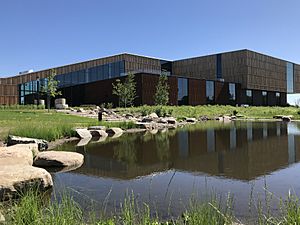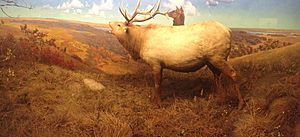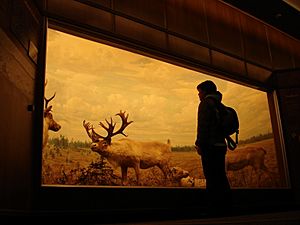Bell Museum of Natural History facts for kids

The Bell Museum in 2018
|
|
| Established | 1872 |
|---|---|
| Location | 2088 Larpenteur Ave W, Falcon Heights, MN 55113 on the St. Paul campus of the University of Minnesota |
| Type | Natural History of Minnesota |
| Owner | University of Minnesota |
The Bell Museum is a cool place to learn about nature and science! It used to be called the James Ford Bell Museum of Natural History. This museum is part of the University of Minnesota and is located on its Saint Paul campus.
The current museum building opened in 2018. Inside, you can see amazing dioramas (3D scenes) that show Minnesota's wildlife. These displays feature animals that live right here in the state. The museum also has a fantastic digital Planetarium where you can explore space.
Contents
Discovering the Bell Museum's History
The Bell Museum was started way back in 1872. The idea was to collect, save, and show off Minnesota's many different animals and plants. This was for scientists to study, for teachers to use, and for everyone to enjoy and learn from. The University of Minnesota is in charge of the museum.
The museum first started in just one room on the university's Minneapolis campus. Later, a doctor and bird expert named Thomas Sadler Roberts helped reorganize it. His friend, James Ford Bell, gave a lot of money to build a new home for the museum's nature dioramas.
James Ford Bell especially wanted a diorama of gray wolves in their natural home. He hoped this would help protect them, because in the 1930s, people were paid to hunt wolves. With more donations and government help, the James Ford Bell Museum of Natural History opened in 1940. Over the years, the building got bigger, but by the 1980s, it had problems like leaks and mold.
A Brand New Building
After many years of planning, a new building for the Bell Museum was approved in 2014. The university got money to build it, and construction started on Earth Day, April 22, 2016.
The new Bell Museum was designed by Perkins and Will. It's located on the Saint Paul campus of the University of Minnesota. The new museum has cool features like an outdoor learning area, its own parking lot, and new exhibit spaces.
Amazing Collections
The Bell Museum has more than 4 million scientific specimens! These collections have been used for research and teaching since 1872. In 2016, the museum launched the Minnesota Biodiversity Atlas. This is an online database with tons of information and pictures of birds, mammals, fish, plants, and fungi from the museum. It helps scientists with their research and conservation efforts.
Amphibian and Reptile Collection This collection has many different Amphibians and Reptiles, especially those found in the upper Midwest of the United States.
Bird Collection Most of the birds in this collection are from Minnesota and the upper Midwest. The Bell Museum has collections for both research and teaching.
Fish Collection The Fish Collection includes fish from an expedition to the Philippines in the 1890s. It also has fish from Hawaii collected in the early 1900s, and many other fish from across the United States.
Fungi Collection About 10% of the Fungi Collection is made up of fungi from Minnesota. The rest of the collection comes from all over the world.
Lichen Collection The Lichen Collection is one of the biggest lichen collections in the United States. It's also one of the few that is completely digital, meaning all the information is online. It holds lichens from around the world.
Invertebrate Collection This collection includes freshwater mollusks found in Minnesota. It also has an older collection of Indo-Pacific mollusks (like snails and clams) from the Minneapolis Library.
Mammal Collection Most of the Mammal Collection includes dry skins and skulls. However, the Bell also has many full skeletons and a growing collection of specimens preserved in fluid.
Vascular Plant Collection This collection contains samples of plant parts like leaves, stems, cones, fruits, and seeds.
Exciting Exhibits

The following descriptions are about exhibits that were in the museum's old location. Some of these might be similar in the new building!
Dioramas The Bell Museum's dioramas are like giant 3D pictures that show Minnesota's natural environments. They feature the birds, animals, plants, and insects that live there. You can see moose, elk, bears, beavers, cranes, fish, and more. These dioramas help you learn animal facts and see how different species survive. Many of these amazing scenes were created between the 1920s and 1940s. A wildlife artist named Francis Lee Jaques painted the backgrounds for many of the large dioramas.
Touch and See Room The Touch and See Room was created in 1968. The museum wanted visitors to be able to touch specimens that are usually kept behind glass. In this room, you can touch bones, furs, and feathers. It also has live animals like snakes, frogs, geckos, cockroaches, and tarantulas! The Smithsonian Institution's National Museum of Natural History even visited the Bell Museum to get ideas for their own discovery room.
Rainforest Gallery "Under the Fig Leaf" is a living rainforest exhibit. It's also an active research project managed by Professor George Weiblen, the museum's Curator of Plants. Many of the plants were grown from seeds he collected in tropical forests around the world. Visitors can see the mini rainforest from both the ground level and from above, learning about related research.
ExploraDome The ExploraDome is a large, inflatable planetarium dome that travels around the state. Museum staff take audiences on a virtual journey from Earth to the edge of the known universe. It's a small, cozy space that holds up to 30 people. All shows are given live by a planetarium educator, so you can ask questions!
Traveling Exhibits The Bell Museum also creates exhibits that travel to other museums and places. These exhibits help people learn more about our natural world and important environmental issues. They can be found in museums, visitor centers, schools, and libraries across the United States and Canada.
Whitney and Elizabeth MacMillan Planetarium
The Minnesota Planetarium Society used to run a planetarium from 1960 until it closed in 2002. In 2011, this society joined with the University of Minnesota's Bell Museum. The new Bell Museum building now has a modern digital planetarium. It uses a special projection system to show amazing views of space.
The planetarium is named after Whitney MacMillan and his wife.
Fun Programs
The museum offers many different programs and events for all ages. You can join science labs, summer camps, and special "Spotlight Science" events. They also have "Sensory Friendly Saturdays" and "After Hours" events. "Star Parties" are a great way to learn about the night sky. All these programs help spark interest in science, technology, art, engineering, and math!
Admission (starting June 14, 2023)
Here are the prices to visit the Bell Museum and Planetarium:
| Museum | Planetarium | Combo | |
|---|---|---|---|
| Adult | $15 | $10 | $21 |
| Senior | $13 | $9 | $18 |
| Youth (3-21) | $12 | $8 | $16 |
| 2 and Under | $0 | $0 | n/a |
| University of Minnesota Student | $0 | $5 | $5 |


